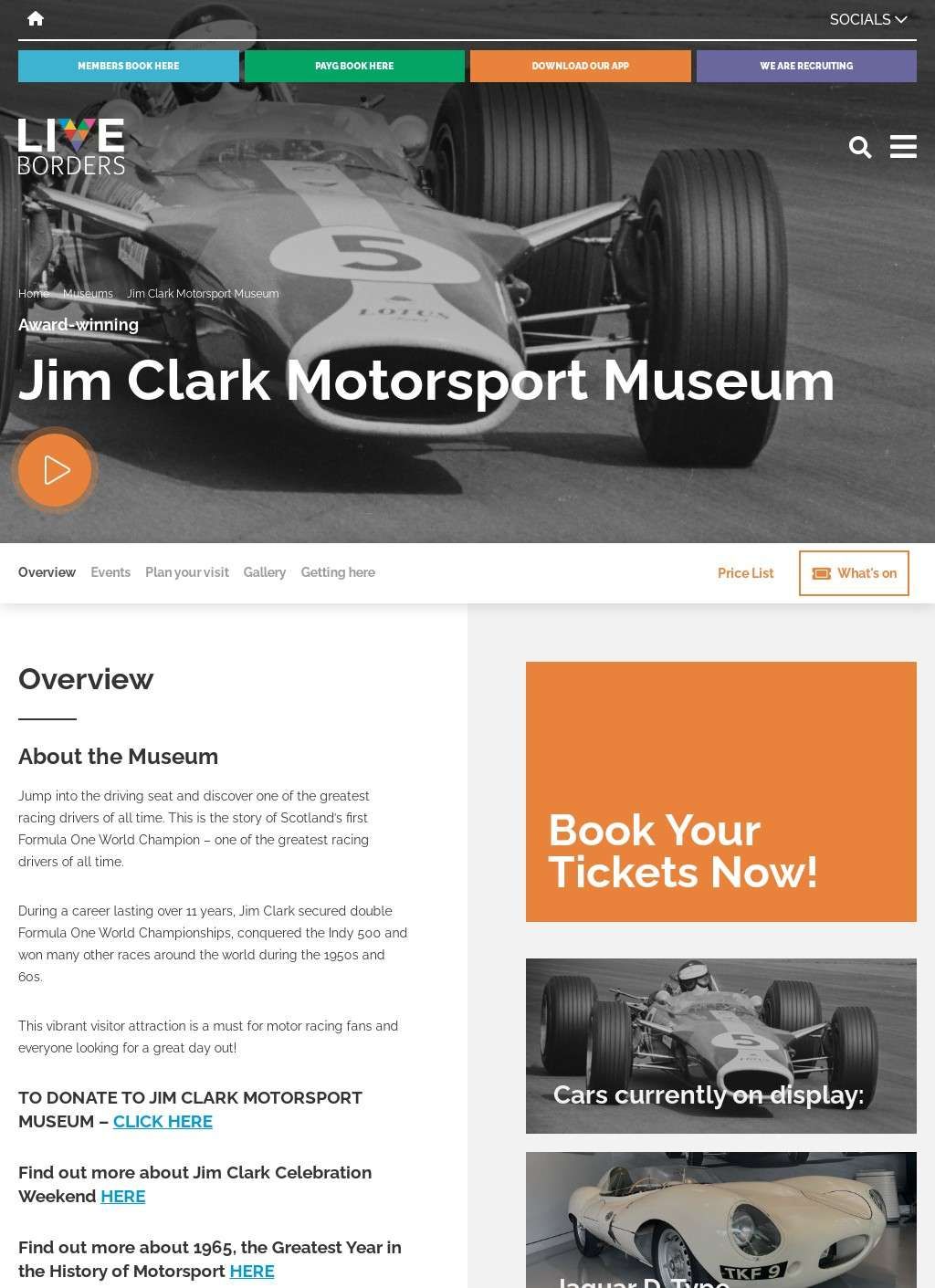The Jim Clark Motorsport Museum in Duns stands as a world-class tribute to Scotland's greatest racing driver and one of Formula One's most naturally gifted champions. Located on Newtown Street in a carefully restored Georgian villa, the museum reopened in 2019 following a £1.6 million redevelopment that transformed the original Jim Clark Room into a state-of-the-art visitor attraction. This cultural landmark not only celebrates Clark's extraordinary achievements on the racetrack but also explores his deep roots in Berwickshire farming life, creating a narrative that resonates with motorsport enthusiasts and local history buffs alike.
The museum's collection encompasses an impressive array of racing cars that span Clark's career from his early days racing for the Border Reivers team to his dominance in Formula One. The centrepiece exhibits include a Lotus 25, the car in which Clark won his first World Championship in 1963, and a Jaguar D-Type that showcases his versatility across different racing disciplines. A Lotus Cortina represents his success in touring car racing, where he helped establish the model's sporting credentials. These vehicles are displayed with careful attention to their historical context, allowing visitors to appreciate both their technical significance and their role in Clark's career progression.
Trophy displays throughout the museum tell the story of Clark's remarkable success across multiple racing categories. The collection includes over 100 trophies ranging from his early victories in local Berwickshire events to the prestigious silverware from his two Formula One World Championships and his Indianapolis 500 victory in 1965. Personal items add intimate touches to the displays, including his OBE medal, racing helmets, and even the watch he received for winning at Indianapolis. These artifacts are presented in custom-designed cases with detailed labeling that provides context about each achievement.
Interactive elements elevate the museum experience beyond traditional static displays. A racing simulator allows visitors to experience the challenge of driving a Formula One car, offering different difficulty levels to suit various ages and abilities. Touchscreen displays provide access to rare archive footage, including onboard camera shots that were revolutionary for their time. Audio stations feature interviews with Clark's contemporaries and family members, offering personal insights into his character and approach to racing. A dedicated cinema area screens documentaries and race footage on a continuous loop.
The museum's approach to storytelling skilfully balances Clark's international racing achievements with his local connections to Berwickshire. Displays explore his upbringing on the family farm at Edington Mains, his education at local schools, and his continued involvement with farming throughout his racing career. This dual narrative helps visitors understand how Clark maintained his humility and connection to home despite achieving global fame. Photographs showing Clark at local events and with farming friends provide a counterpoint to images of him with racing celebrities and royalty.
Educational programmes form an important part of the museum's mission to inspire future generations. School visits are accommodated with age-appropriate activities including treasure hunts where children search for toy cars hidden throughout the displays. Workshop sessions explore topics such as aerodynamics, safety developments in motorsport, and the physics of racing. The museum works with local schools to support curriculum topics in science, technology, and history. Special events throughout the year include talks by motorsport personalities and themed activities during school holidays.
Accessibility has been carefully considered in the museum's design, ensuring all visitors can enjoy the experience regardless of mobility challenges. Step-free access is provided throughout, with ramps connecting different levels and automatic doors at the entrance. Wide corridors accommodate wheelchairs and mobility scooters comfortably. Display cases are positioned at heights suitable for wheelchair users, and seating areas are distributed throughout the exhibition spaces. A visual guide available on the museum website helps visitors with autism or anxiety prepare for their visit.
The museum shop offers a carefully curated selection of merchandise that appeals to different visitor interests and budgets. Books about Jim Clark and motorsport history include titles by respected authors and journalists who knew Clark personally. Model cars range from affordable toy versions to detailed collector pieces. Clothing items feature vintage-inspired designs celebrating Clark's racing numbers and team colours. Local products including Scottish-made gifts provide souvenirs that connect to the museum's Berwickshire location. Postcards and prints of historic photographs offer affordable mementos.
Community engagement extends beyond the museum walls through various initiatives that celebrate Clark's legacy and promote Berwickshire. The Jim Clark Trail, a 50-mile driving route, guides visitors through locations significant to Clark's life including his grave at Chirnside Parish Church and past the former airfield circuits where he competed in his early career. The museum supports the annual Jim Clark Rally, which brings motorsport back to Berwickshire roads. Partnerships with local businesses include the Jim Clark Cafe Bistro in Duns, creating a wider visitor experience that benefits the local economy.
Managed by Live Borders on behalf of the Jim Clark Trust and Scottish Borders Council, the museum operates as part of a wider network of cultural facilities across the region. This arrangement ensures professional museum standards while maintaining strong community connections. Opening hours vary seasonally, with extended summer hours accommodating increased tourist traffic. Adult admission is £7.95, with concessions for seniors and students at £6.95, children at £3.95, and family tickets at £19.95. Annual passes offer excellent value for repeat visitors. The ticket price includes access to all exhibits and interactive features, with tickets valid for 12 months to encourage return visits.
Visitor amenities enhance the museum experience with thoughtful provisions for comfort and convenience. The reception area includes a welcoming space where staff provide information about the museum and wider area attractions. Accessible toilets are available on-site. While the museum doesn't operate its own cafe, its central location in Duns places it within walking distance of several cafes and restaurants. Parking can be found on nearby streets and in public car parks, though spaces directly outside the museum are limited. Contact is available through telephone (01361 883960) or email via the Live Borders website, with staff happy to answer queries about visits or group bookings.
